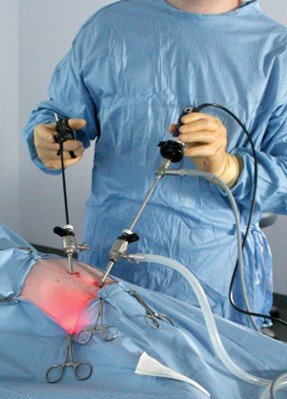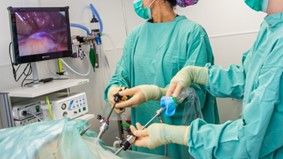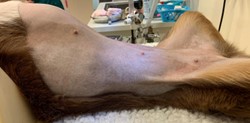Laparoscopic Spay



What is Laparscopic Spay
Is every female dog a candidate for keyhole surgery
For very small dogs, if there is not enough space for our keyhole cameras and instruments, traditional open surgery is safer so this will be discussed with your vet to ensure the most appropriate surgery is undertaken.
For older dogs, who may already have early stages of disease in their womb or for dogs with confirmed disease of their womb, traditional open surgery to allow easy removal of their womb is advised. We would also recommend open surgery in patients that are severely overweight, although, as with our traditional surgeries, a pre-surgical weight loss programme to reduce overall increased risk would be recommended.
Why choose Laparoscopic Ovariectomy
The advantages of Laparoscopic Ovariectomy are as follows:
- There is a reduction in the amount of pain after the keyhole spaying operation.
- The surgical wounds are much smaller with keyhole surgery: 0.5 to 1 cm compared to 6 to 15 cm which mean your dog is likely to have a speedier recovery.
- Your pet will return to their normal level of exercise sooner. Normally she must rest for 10-14 days, but after laparoscopic surgery only 5 days rest is required on average.
- There is a significantly reduced risk of complications.
- Bleeding from the surgical site is less due to the surgeon having much better visualisation of the ovaries and using advanced equipment to seal the vessels.
What does Laparoscopic Ovariectomy involve
In many ways the process is similar to the traditional spay, all aspects of pre-surgical preparation are identical and your pet will only need to be with us for the day.
The main difference is the process once your pet is under anaesthetic.
- Two small wounds are made on the dog’s under-surface.
- A small amount of gas is introduced internally through the first wound, to lift the body wall away from the internal organs, creating an internal ‘tent’ effect.
- A small camera is then inserted into the patient through the same wound to see the ovaries.
- Surgical instruments are inserted through the second wound to remove the reproductive organs.
- In female dogs, we only remove the ovaries and leave the womb (uterus) inside.
Does keyhole spaying have any downsides
For keyhole surgery, we clip a larger area of fur extending up both sides of the dogs. This allows us to pick up the ovaries internally from the outside as they are actually very close to the spine of a dog.
Complications can happen with any surgery, but they are very rare.
In the worst case, keyhole surgery is converted to traditional open surgery, with no long-term consequences.
Please note that laparoscopic spay cost more than a traditional spay because it requires the use of highly specialized equipment, including small cameras, video screens and special instruments, some of which can only be used once.
Why leave the womb inside
If only the ovaries are removed, what are the health risks to my pet if the womb is left inside?
Simple removal of the ovaries is less traumatic than combined removal of the ovaries and womb.
Womb disease in dogs, including infection and cancer, are mainly due to the female hormone, oestrogen.
Oestrogen is produced by the ovaries, so as long as these are removed, the risks of womb diseases are very small.
Traditional Spay
- 5 – 10 cm incision
- Pain & bruising from blindly tearing ovarian ligament
- Post-operative pain
- Open surgical procedure
Laparoscopic Spay
- 1 – 3 Tiny Holes
- Reduced pain due to precise surgical cuts
- Up to 65% less post-operative pain
- Minimally invasive technique reduces chance of infection

